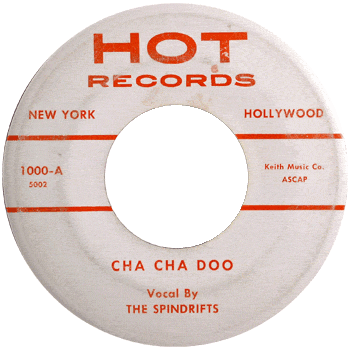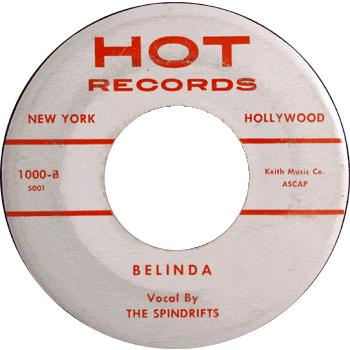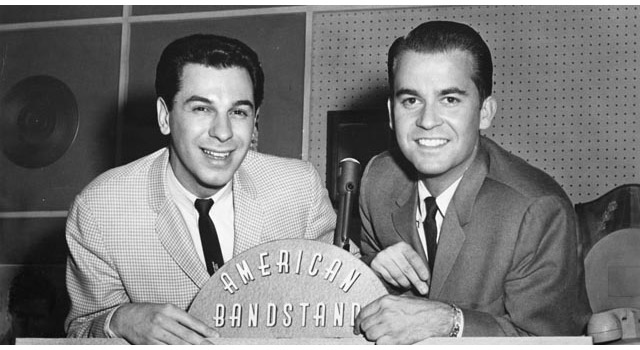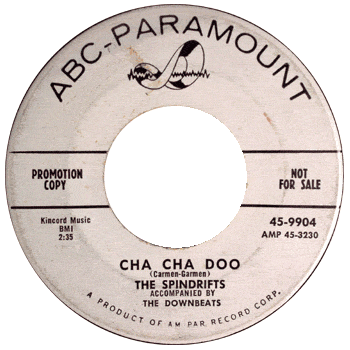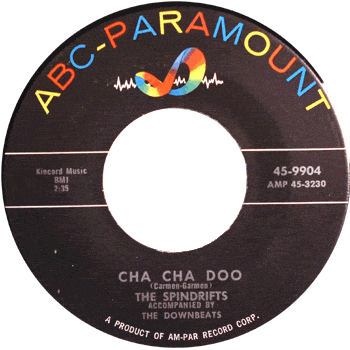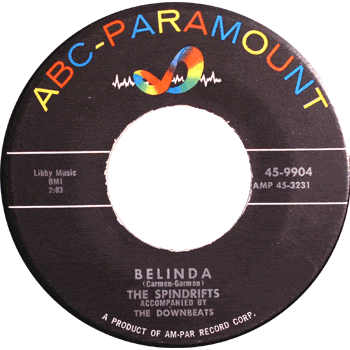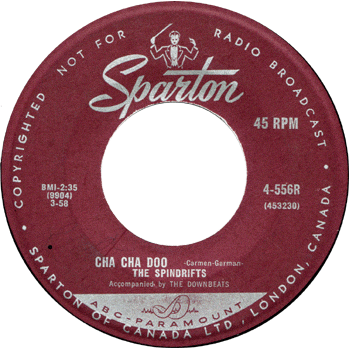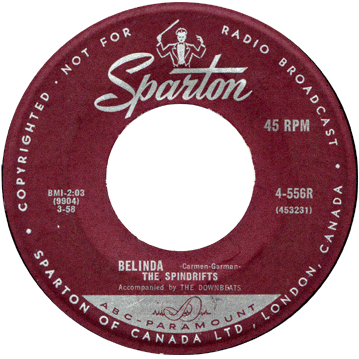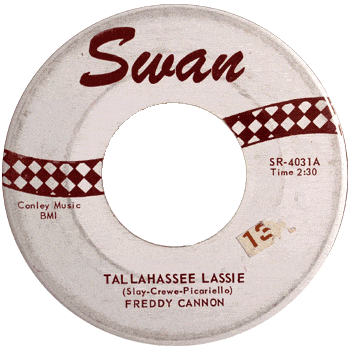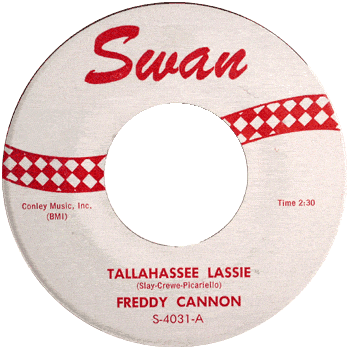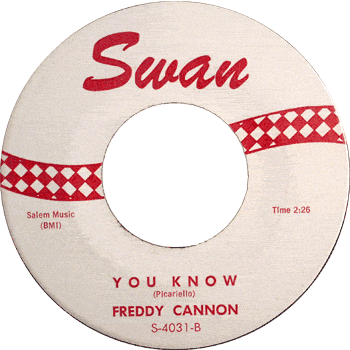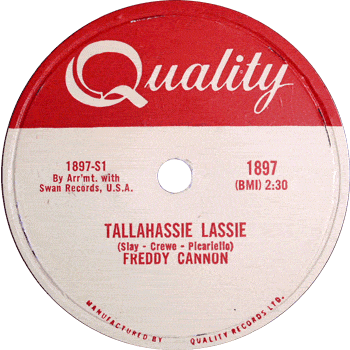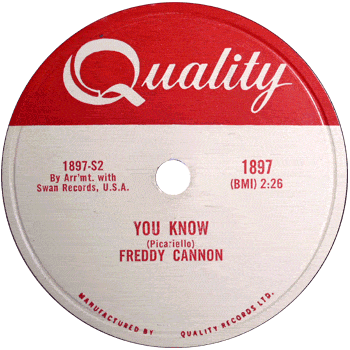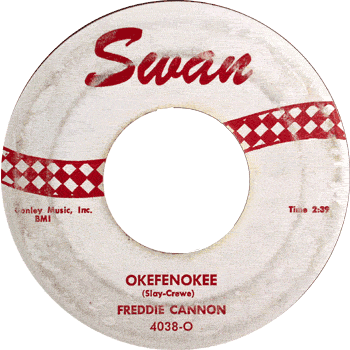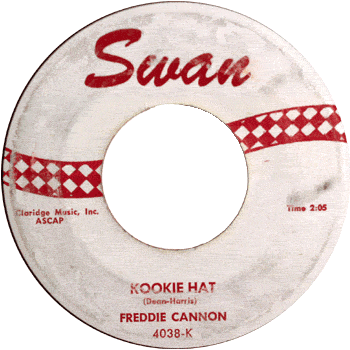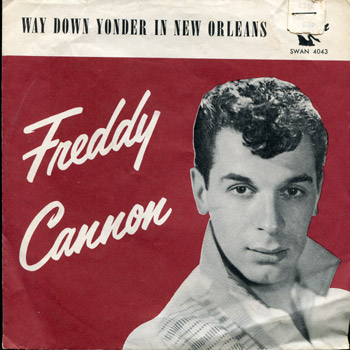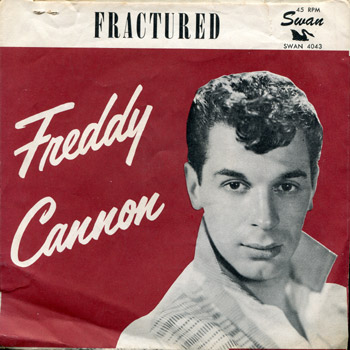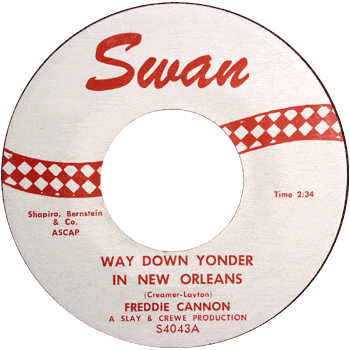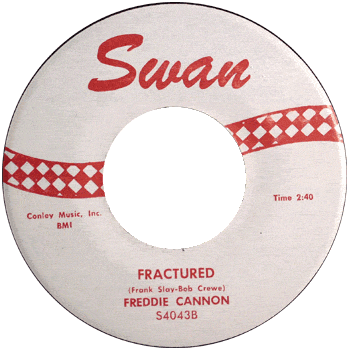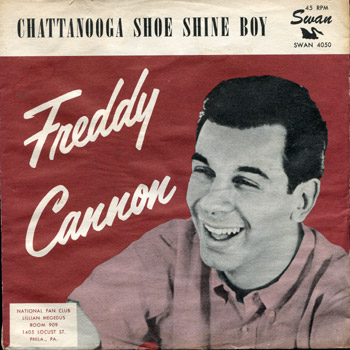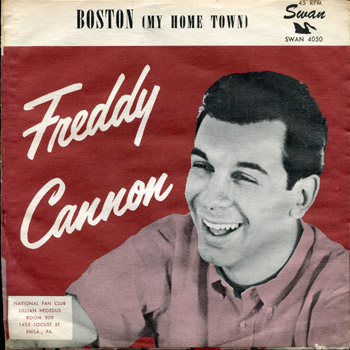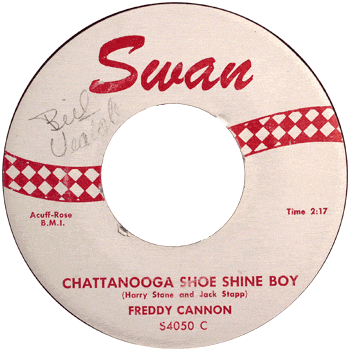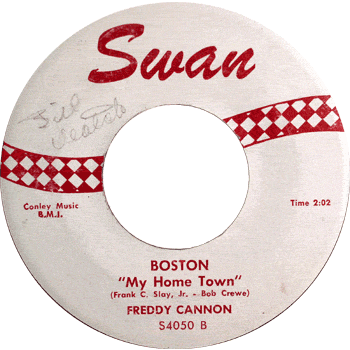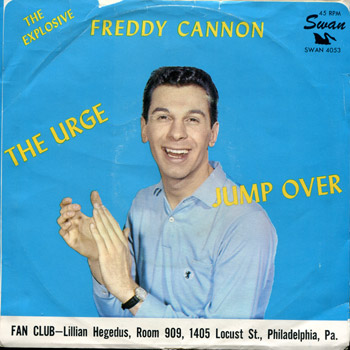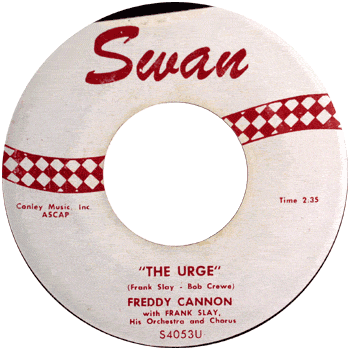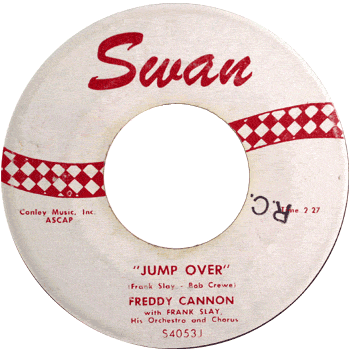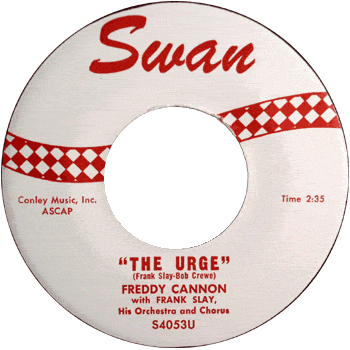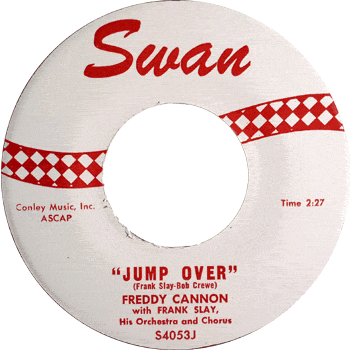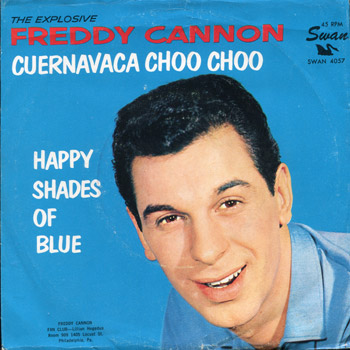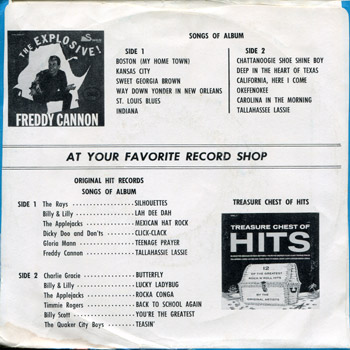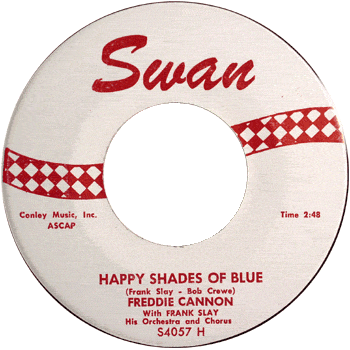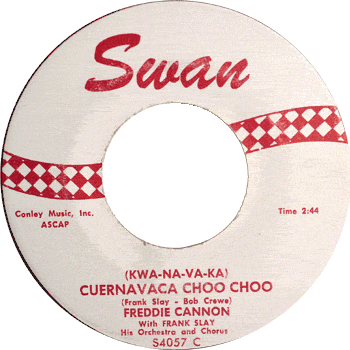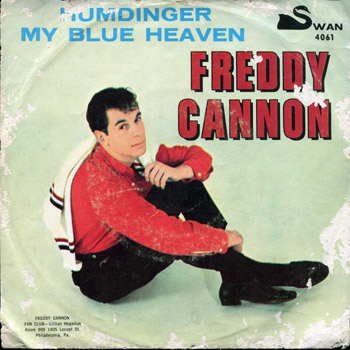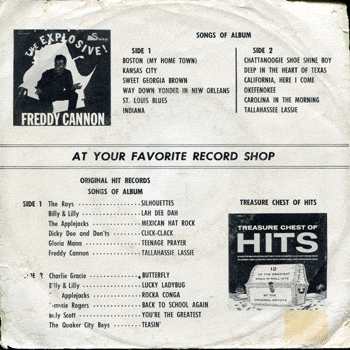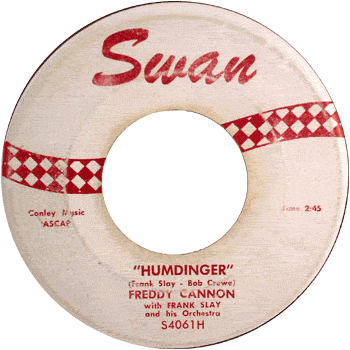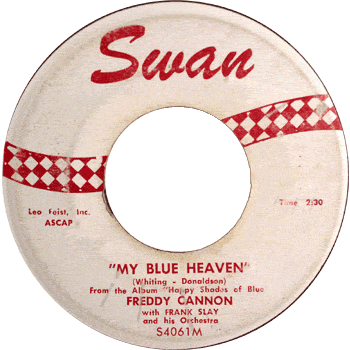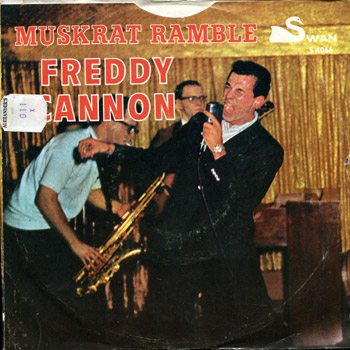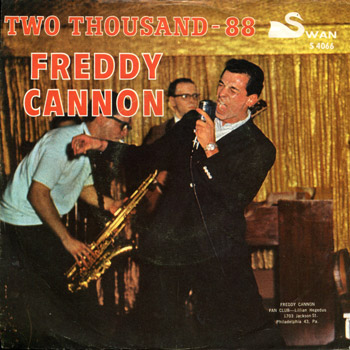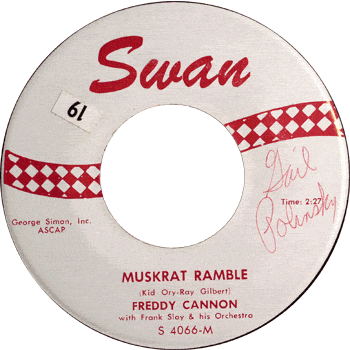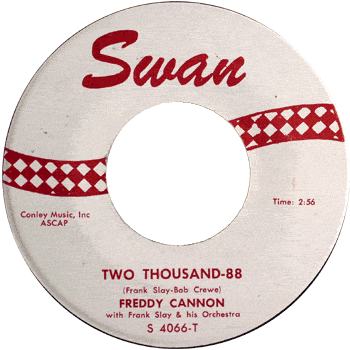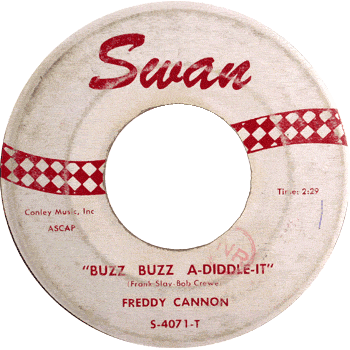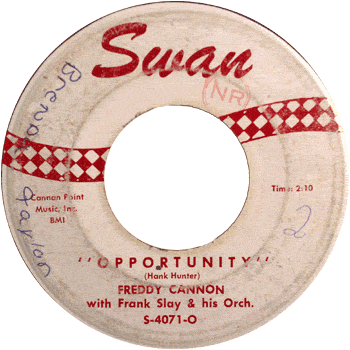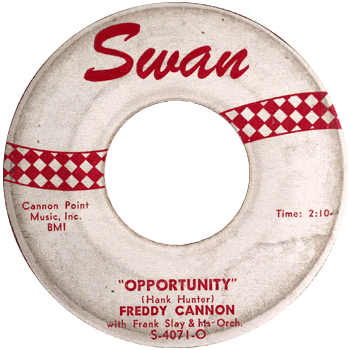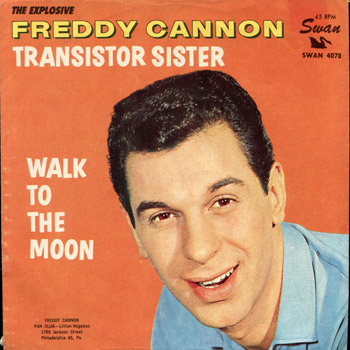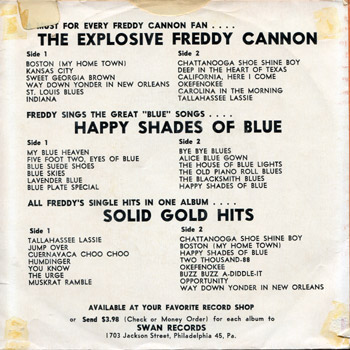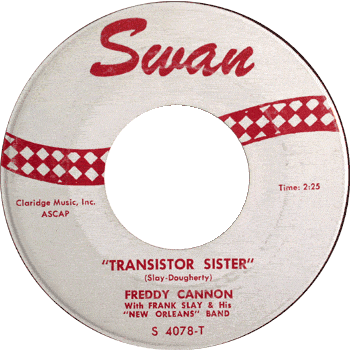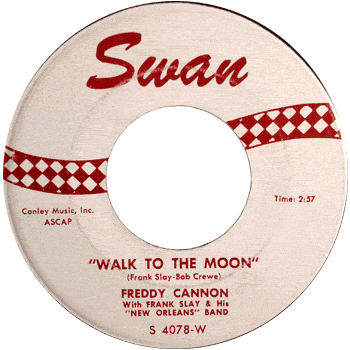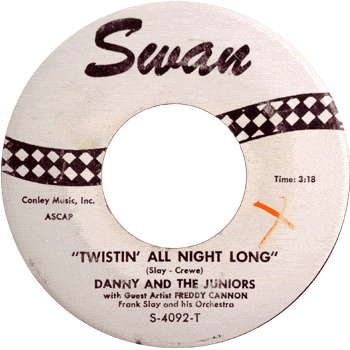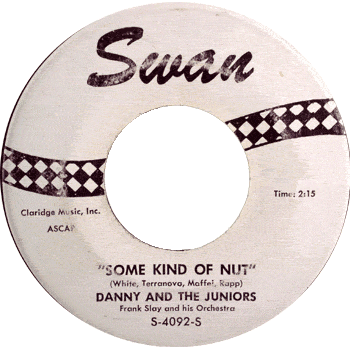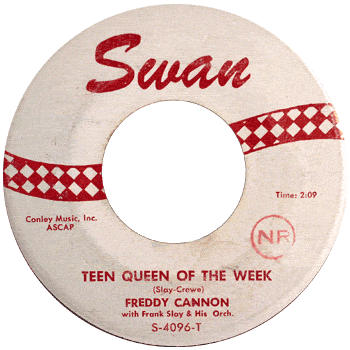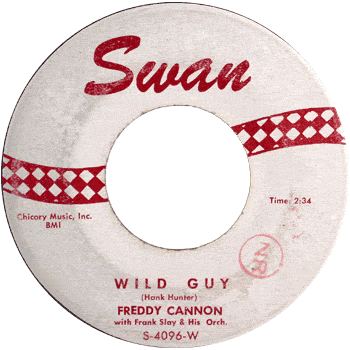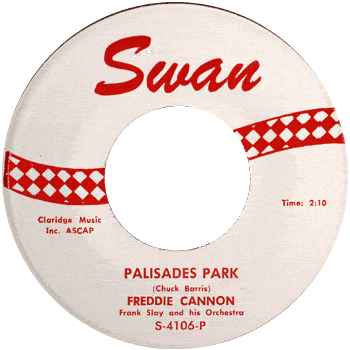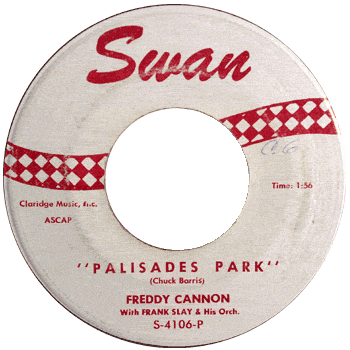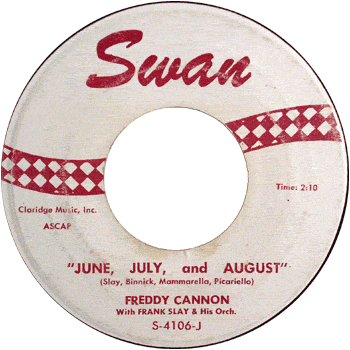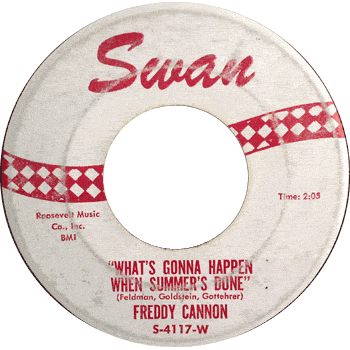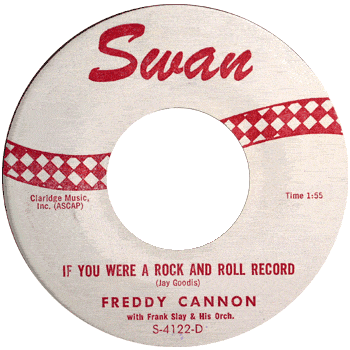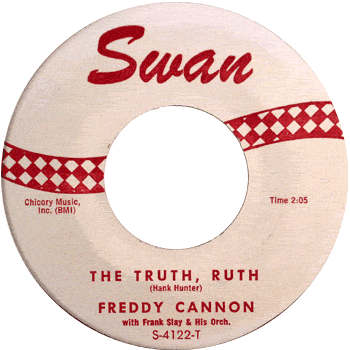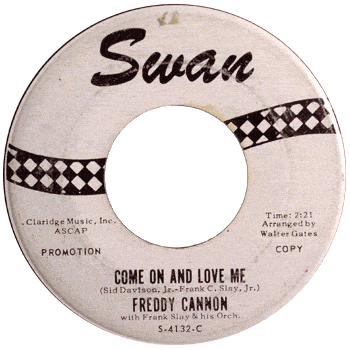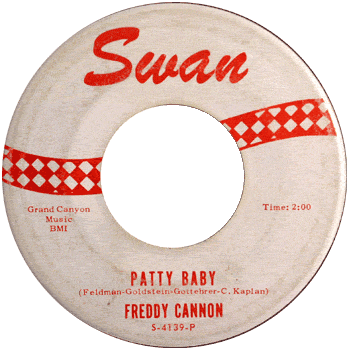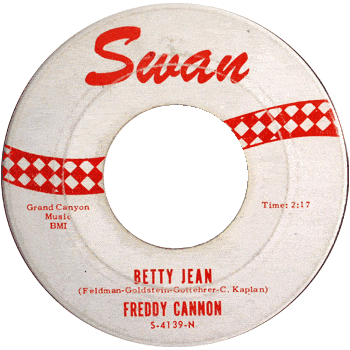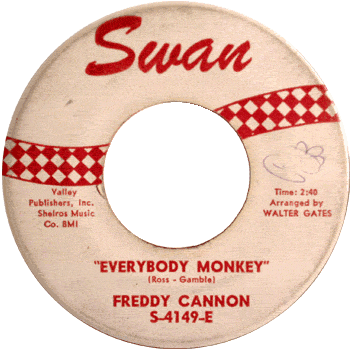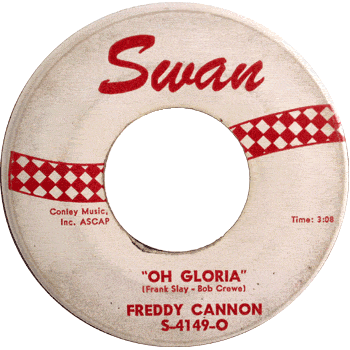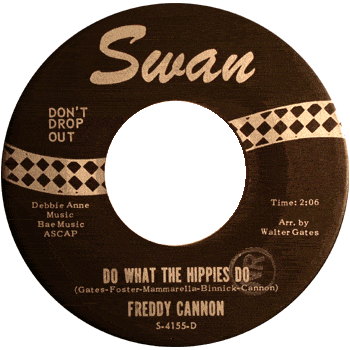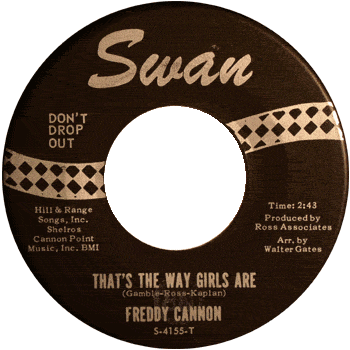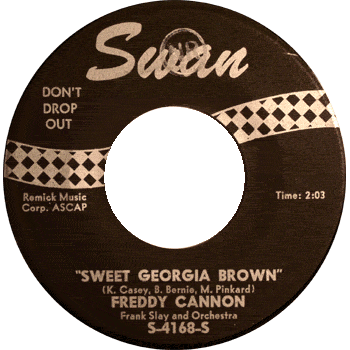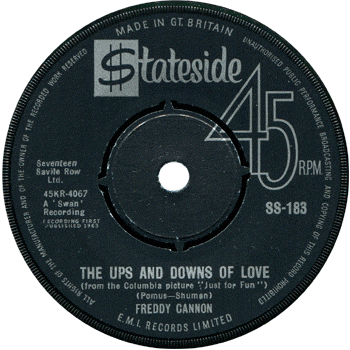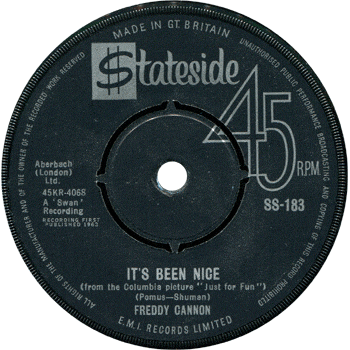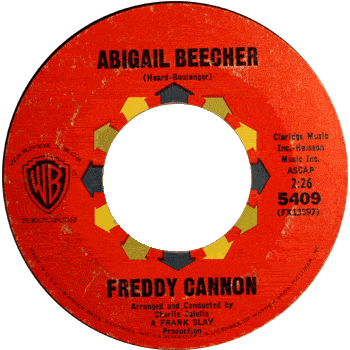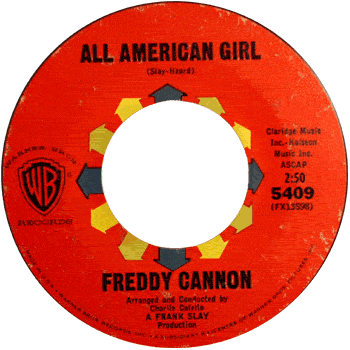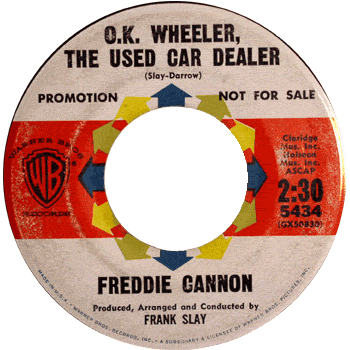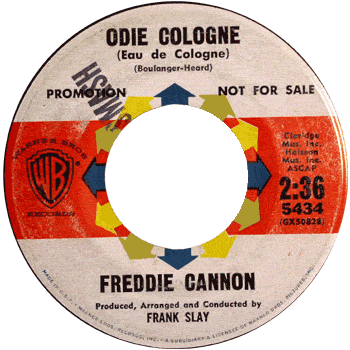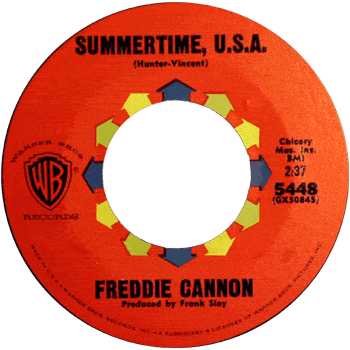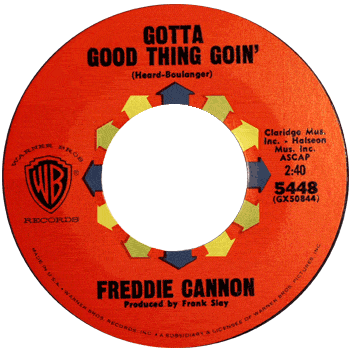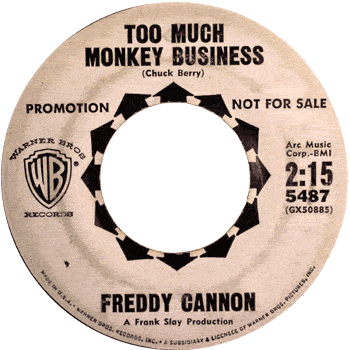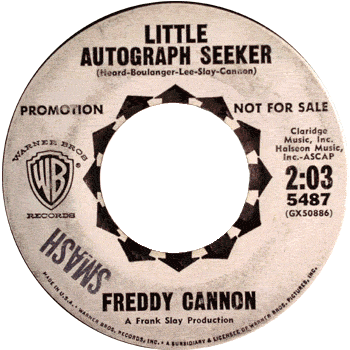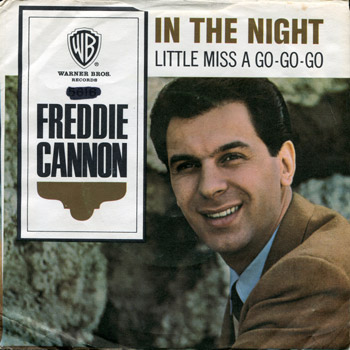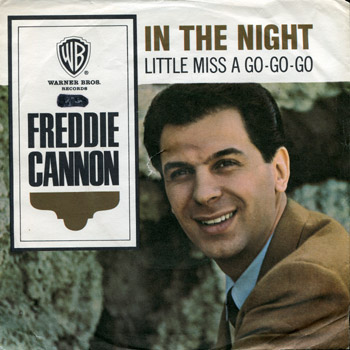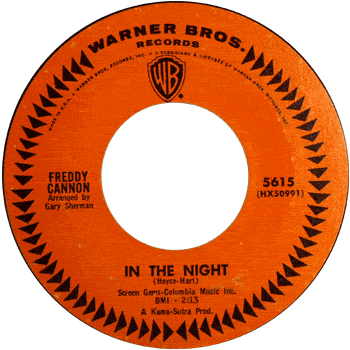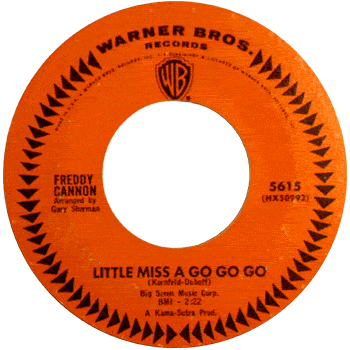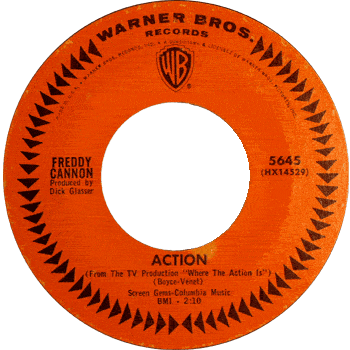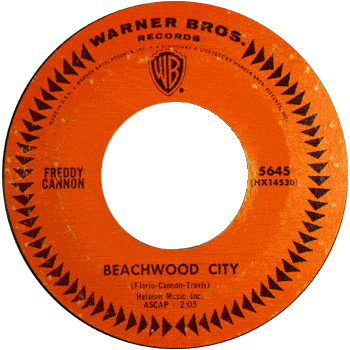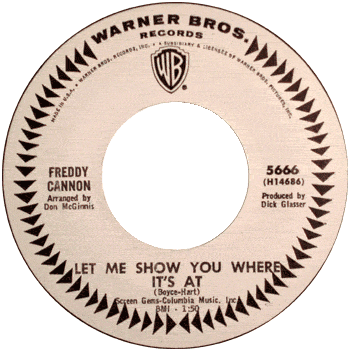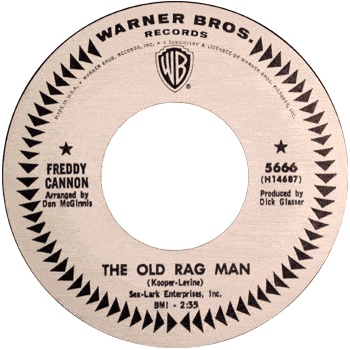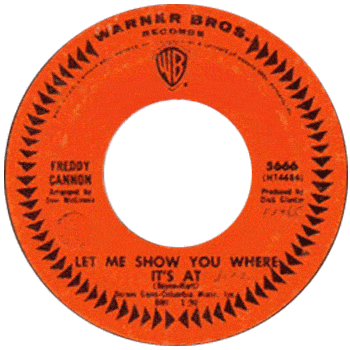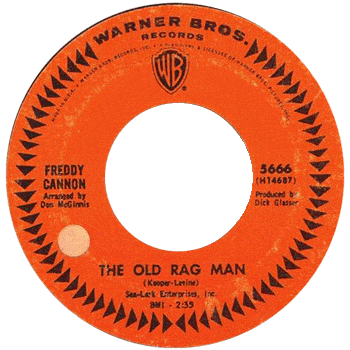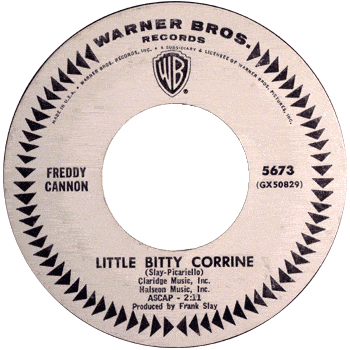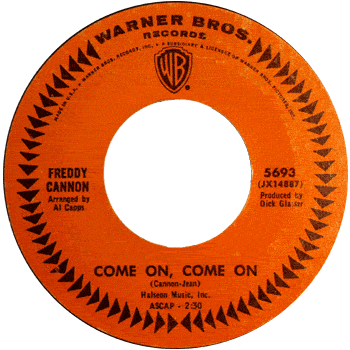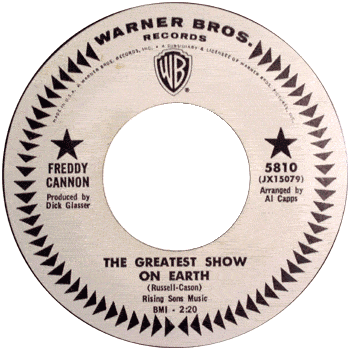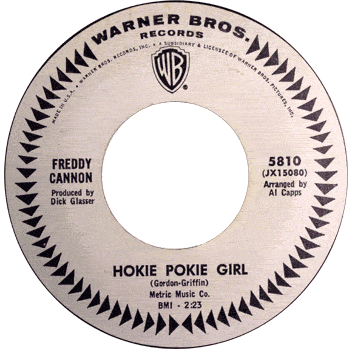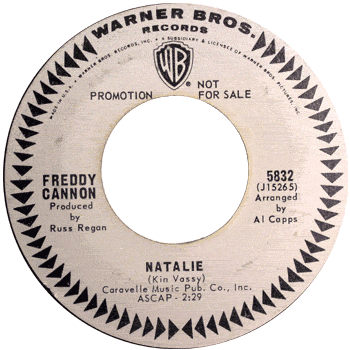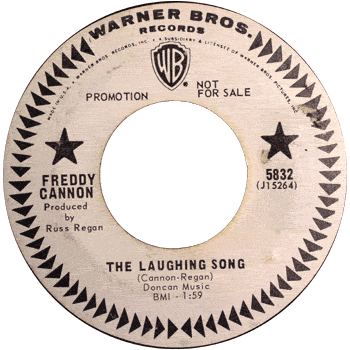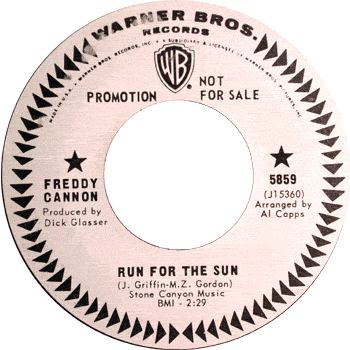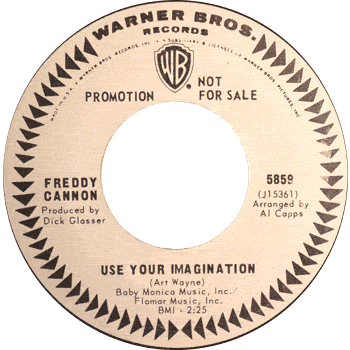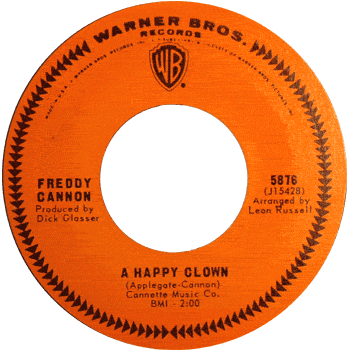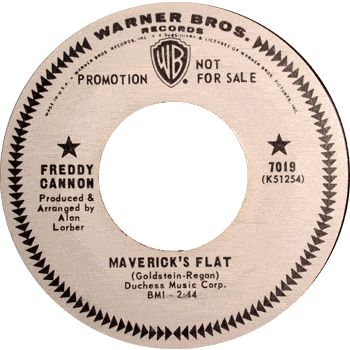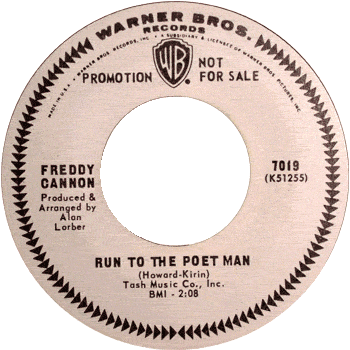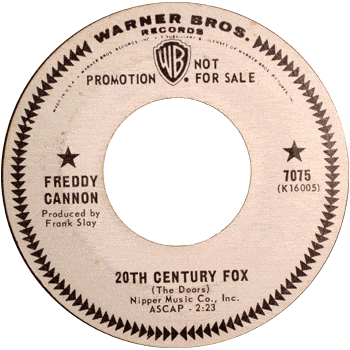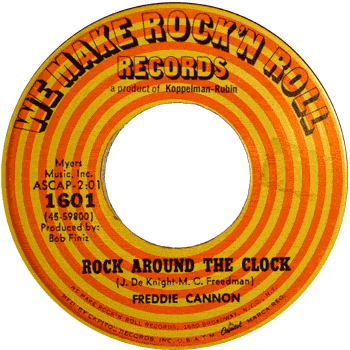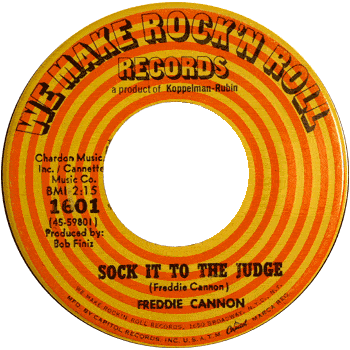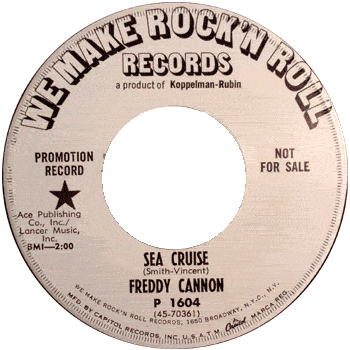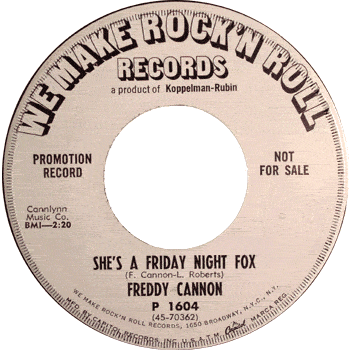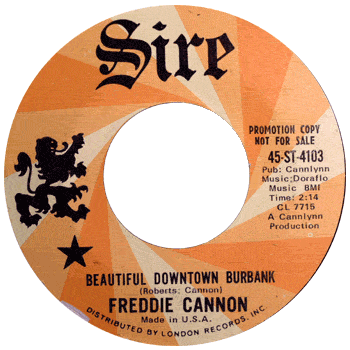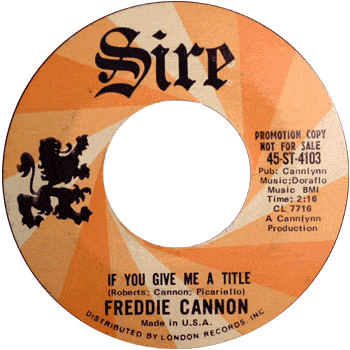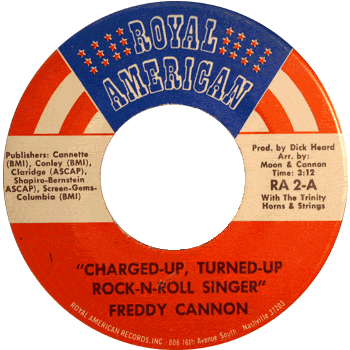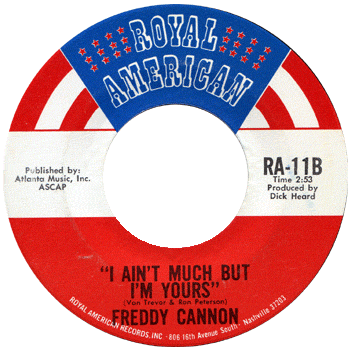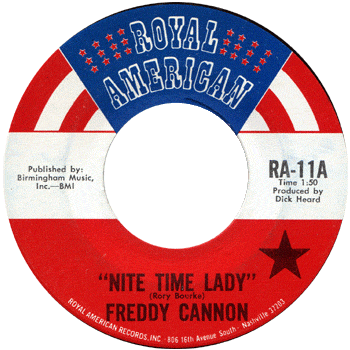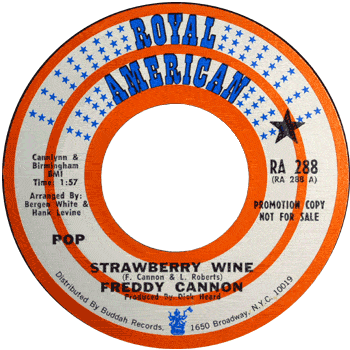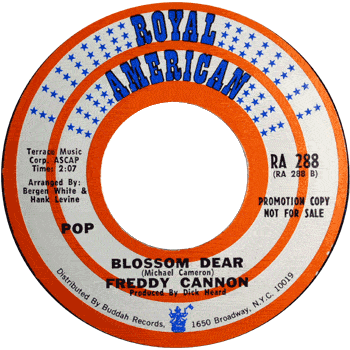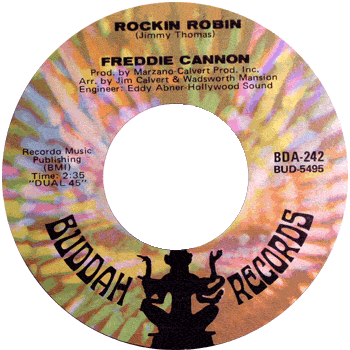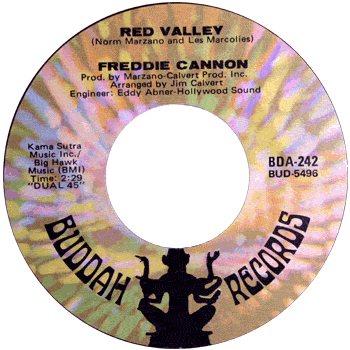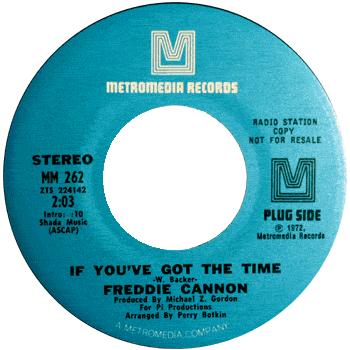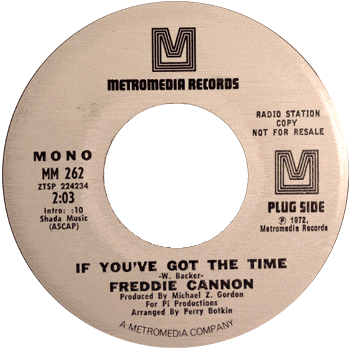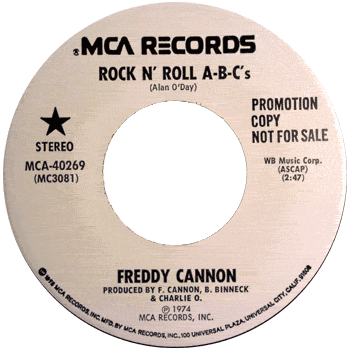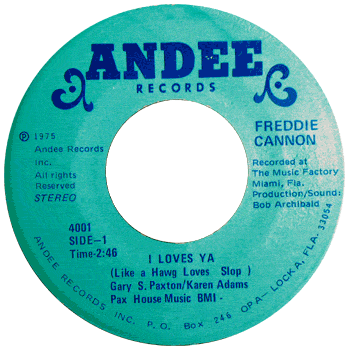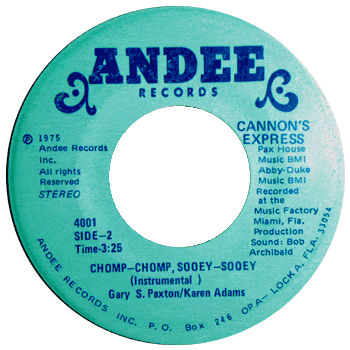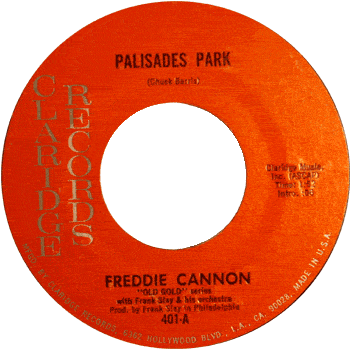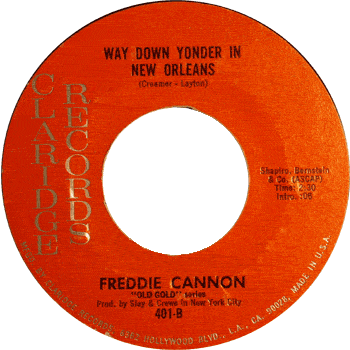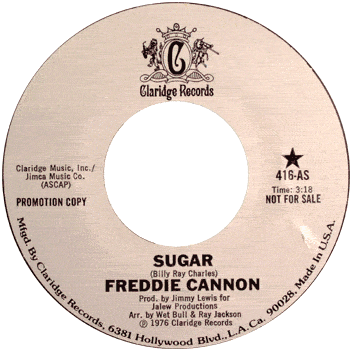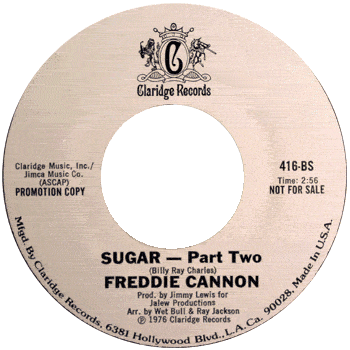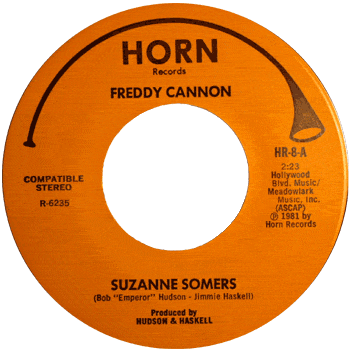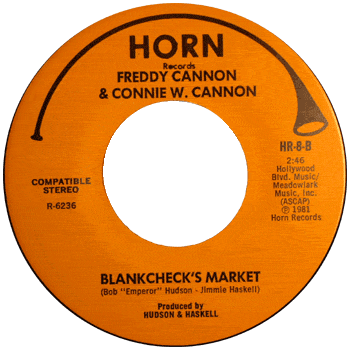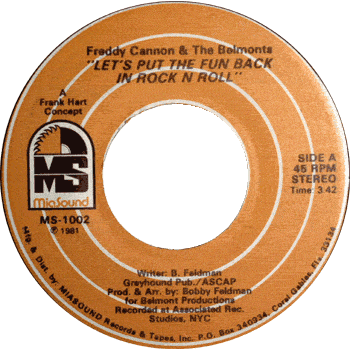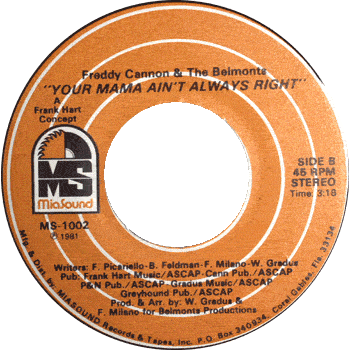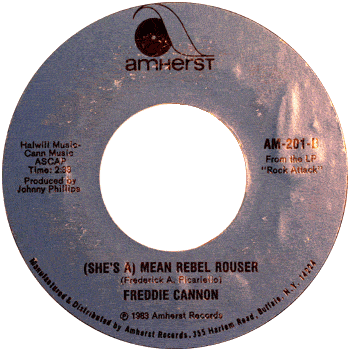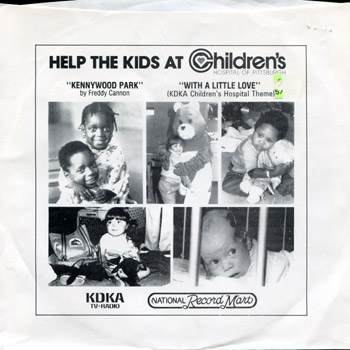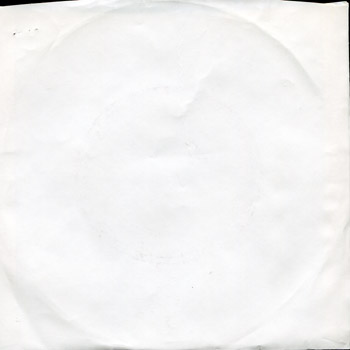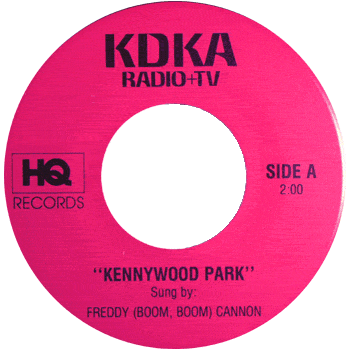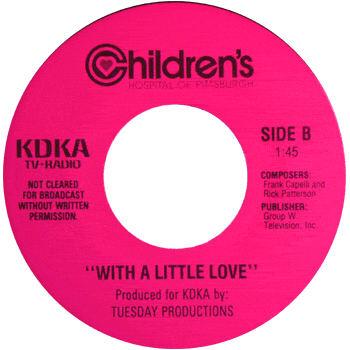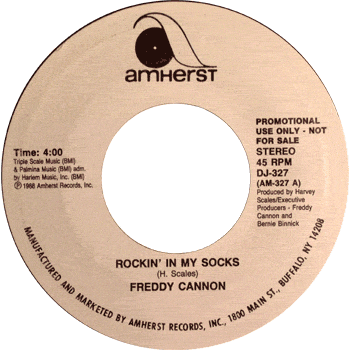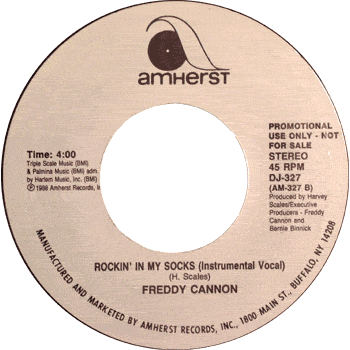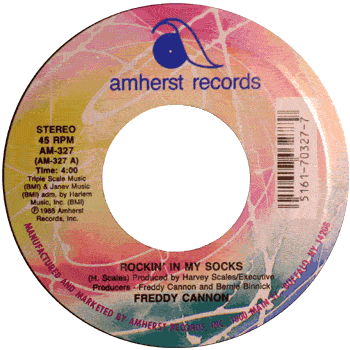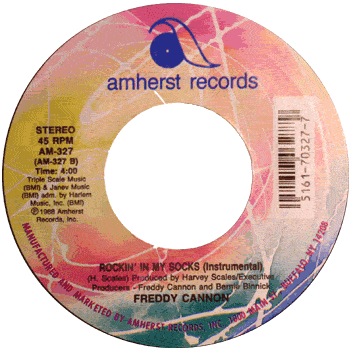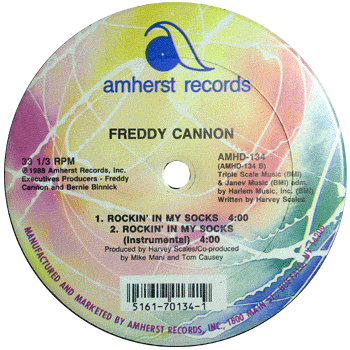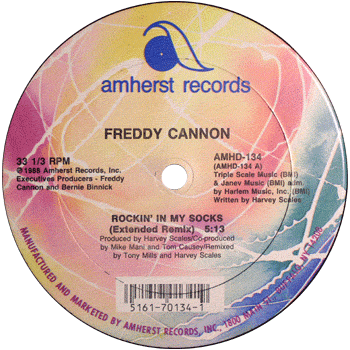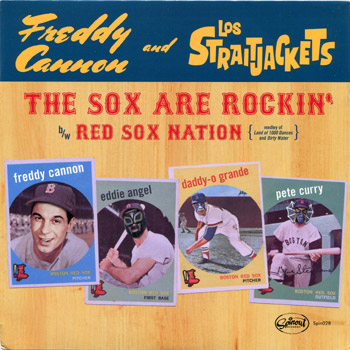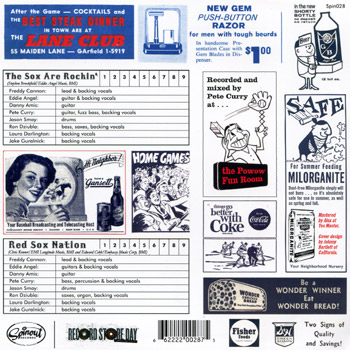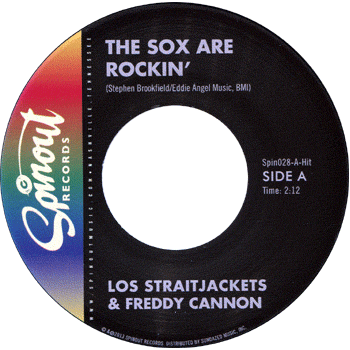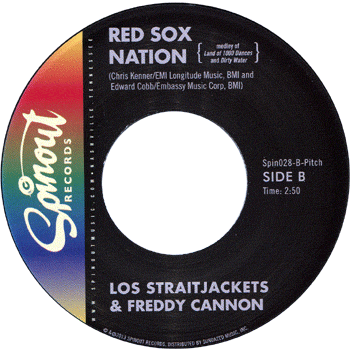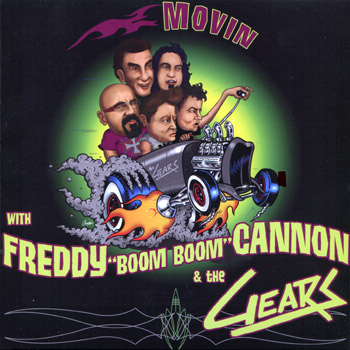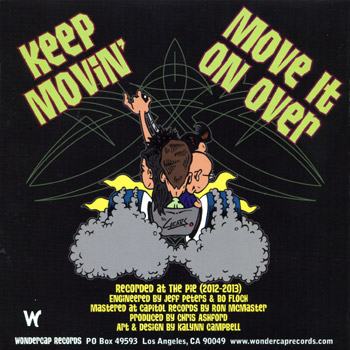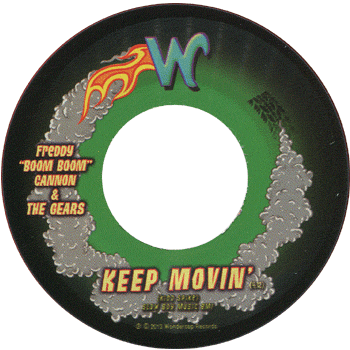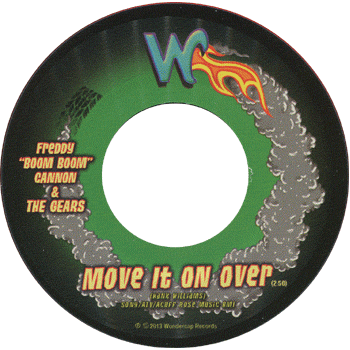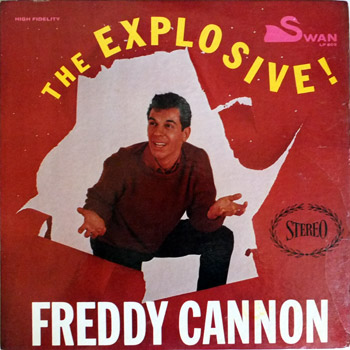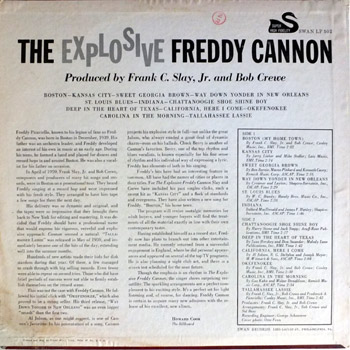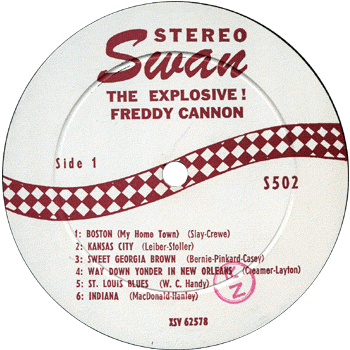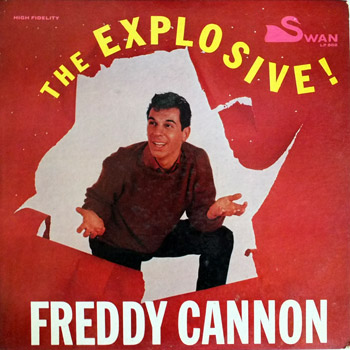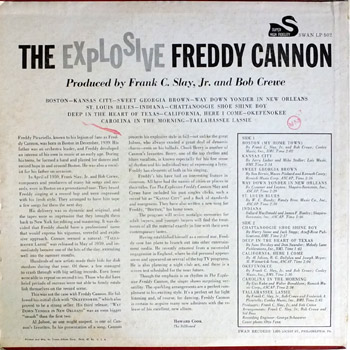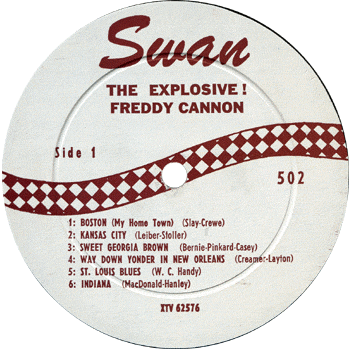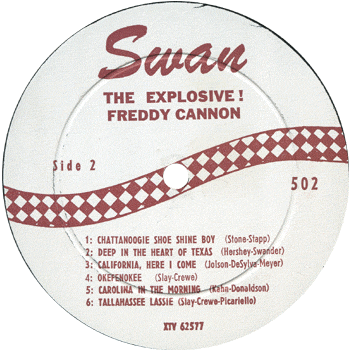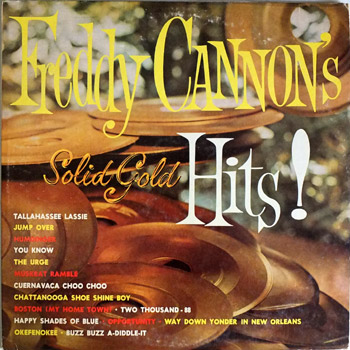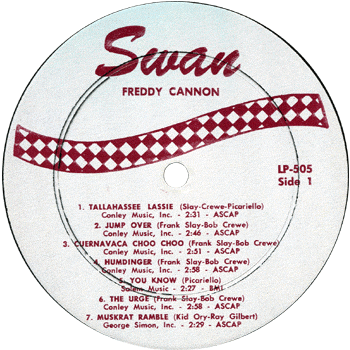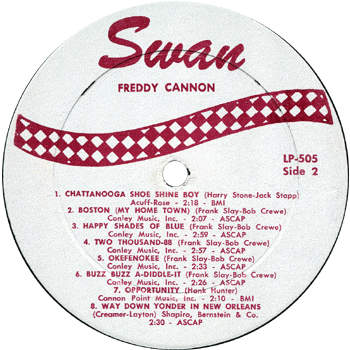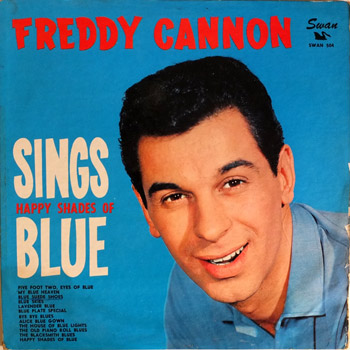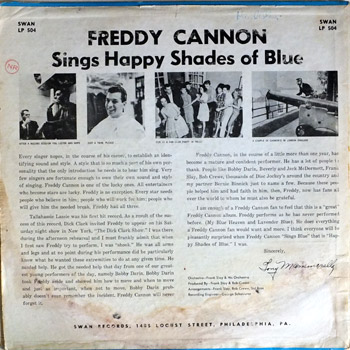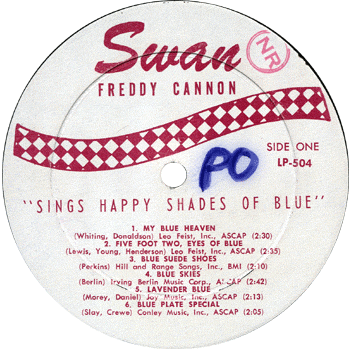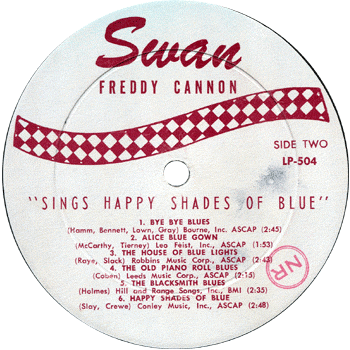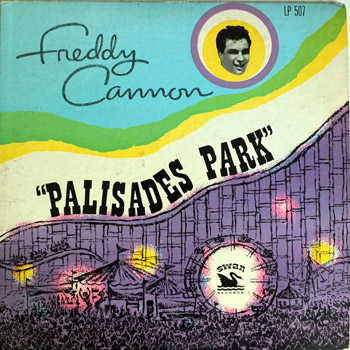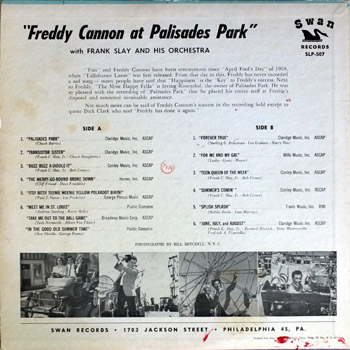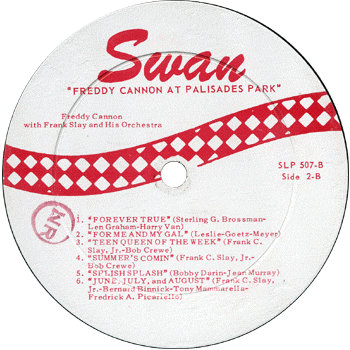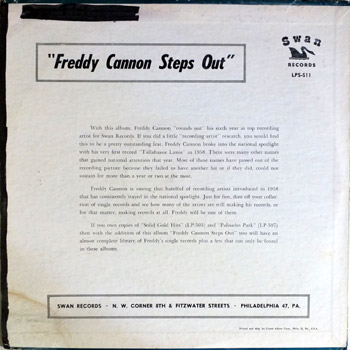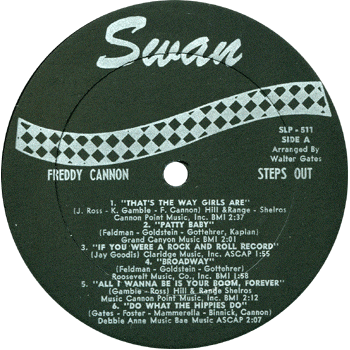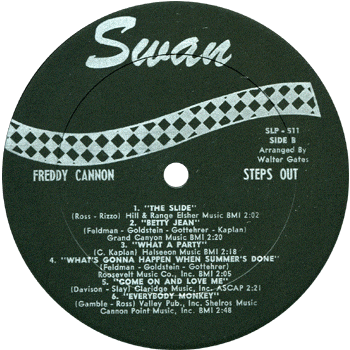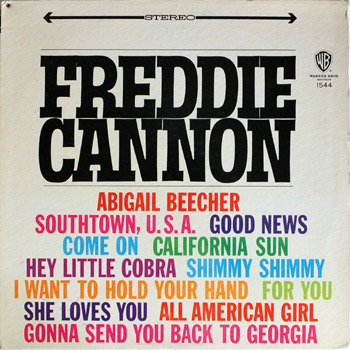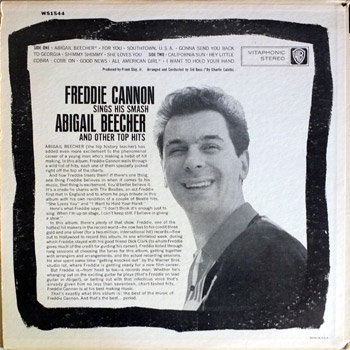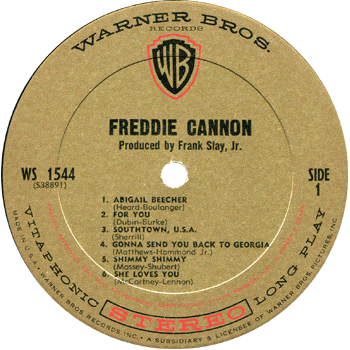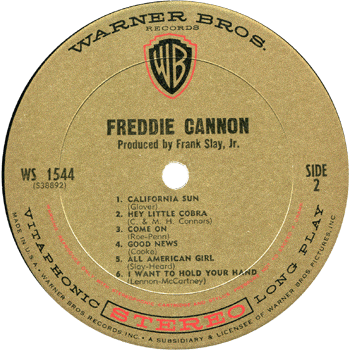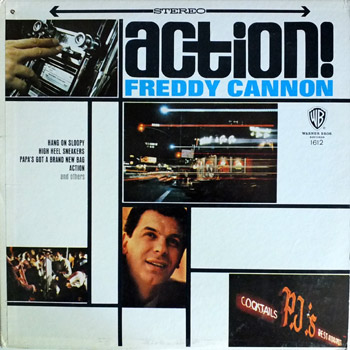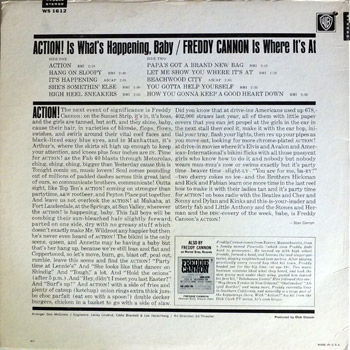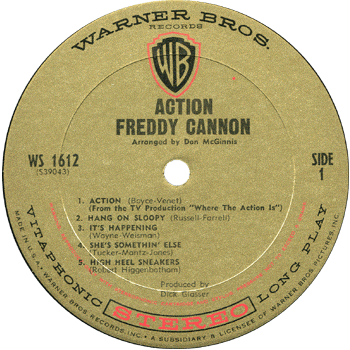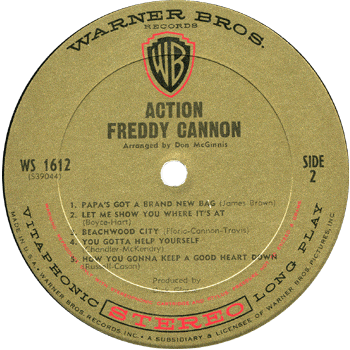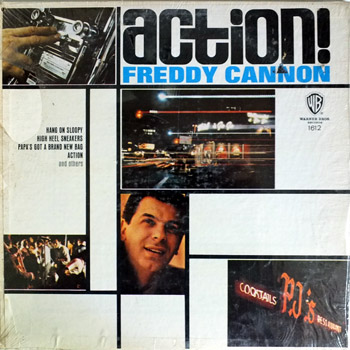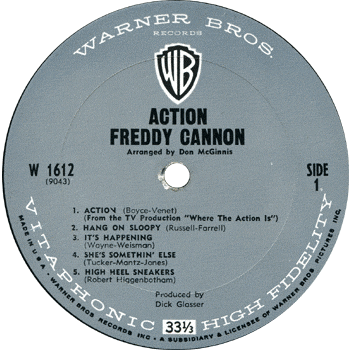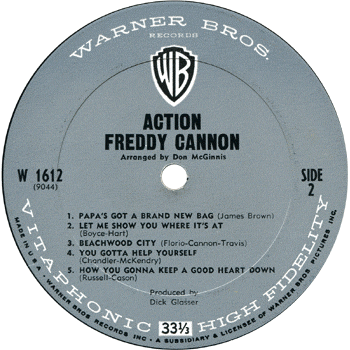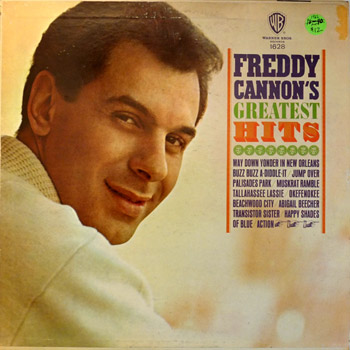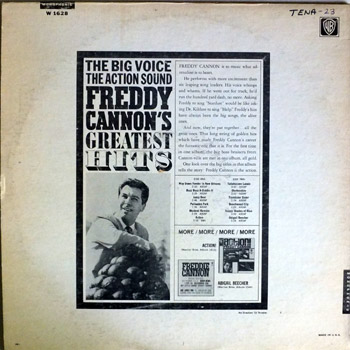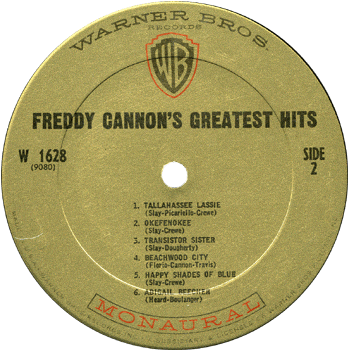Colorradio.com - Freddy Cannon
Must Have Javascript on
For The Slideshow To Work
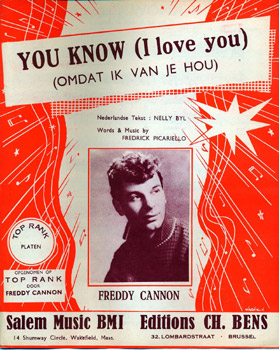
Born Frederick Anthony Picariello, Jr. in 1940 in the town of Revere, Massachusetts, he grew up in nearby Lynn, close to Boston's North Shore. His Dad was a trumpet player in a small dance band that played in and around the Boston area. Freddy's first band was called Freddy Karmon and the Hurricanes, and they played hops and dances in the New England area. Many of the engagements were done for free, just so their name could be used for promotional purposes. It was a barter system of sorts. They played at no charge, and their name was advertised on the radio stations like WMEX and WLYN, and promotional flyers for all the events. He also became a regular on Television station WHDH with DJ Bob Clayton's "Boston Ballroom", the local TV dance show. Freddy Cannon recorded his first song under the name the Spindrifts. "Cha Cha Doo" was a local hit and was first released on the Hot label, later to be issued on ABC Paramount. His first record for the Swan label was called "Tallahassee Lassie". The song was written by, or at least started by Cannon's Mom. What it started out as and how it ended up seem to be two different songs, and Freddy reportedly didn't care for the final version. The public disagreed! It went on to become a huge nationwide smash in the US, and was also wildly popular Internationally. He earned the name "Boom Boom" based on the driving drum beat in his first and subsequent recordings. I have read one account that Kenny Paulson did lead on guitar on Tallahassee Lassie, and it was very distinct. His third release was an old standard that was reworked into the standard high energy rock and roll style of Freddy Cannon. "Way Down Yonder In New Orleans" sold more than Tallahassee Lassie. His next huge hit was called "Palisades Park". The flip, "June July and August" was intended to be the "A" side, but the DJ's flipped it and Freddy Cannon had a 2:10 minute smash hit. Palisades Park was written by Chuck Barris, host of the 1970's "The Gong Show". Cannon left Swan records for Warner Brothers, where he felt he could get a good deal, artistic freedom, and because Swan was faltering. His first release for the new label resulted in the hit "Abigail Beecher". Several issues later, his biggest hit for the label, "Action", was also the theme song used for the Dick Clark show of the same name. After Warner Brothers, Freddy Cannon was on many different record labels, but continued to record, though somewhat sporadically. His last chart hit came out in 1981, and it was called "Let's Put The Fun Back In Rock And Roll", using the Belmonts for his backup. It should have charted higher and was a great record. Freddy Cannon appeared on American Bandstand over 100 times, the most of any current or past performer. He also appeared on Dick Clark's Saturday Night Beechnut show, which was a great dance party style show out of New York. He continues to perform many shows every year, and is now based on the West Coast. When he performs, there is no doubt that you get 110 per cent, as he really puts on a show. Take a look at the label shots of most of Freddy Cannon's great US recordings.
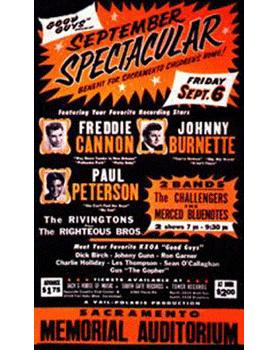
The first vinyl recording for Freddy Cannon was with a group called the Spindrifts. The "A" side was "Cha Cha Doo" and had decent airplay throughout the Northeast and beyond. The flip was "Belinda". Shown is the first issue on the "Hot" label, a small company that does not appear related to the record company that Larry Hall first recorded on. This appears to be the stock issue. Released in early 1958.
ABC picked up the record and attempted to distribute it nationally. Instead of Keith Music company, credit is now given to Kincord music on the plug side. Libby is listed on the flip. Also, the writing credits are now shown as well as accompaniment by the Downbeats. The white label promo copy os shown.
Here is the stock issue that ended up on many east coast record players. Most of the information is the same, just placed on the label differently than the promotional issue.
Sparton records of Canada also issued the record. Maybe it was because the record was breaking in the Northeast, or maybe because any record that showed promise would generally end up on Sparton, or one of several other small Canadian labels. Although the label says "Not For Radio Broadcast, it is actually a stock copy, and many of the stock copies have those words on them. A promotional copy mentions it on the label and is normally white.
Freddy Cannon had his first record as a single artist in May of 1959. Mostly written by Freddy's mother, Tallahassee Lassie stormed the Billboard pop charts, parking at the number 6 position. Not a bad debut! "You Know" was on the flip. A slow song with a decent guitar, and quite a difference from Tallahassee Lassie.
A slightly different variation of the 45 is shown above. The red on the label is much brighter, and continues boldly through the Swan label releases. The titles are in a bigger font on this issue.
Although no USA 78's were released by Freddy Cannon, the Quality label out of Canada certainly did. This is the only 78 Quality label issued of Freddy Cannon. There are some other 78's released of Freddy Cannon in other countries, but on a very limited basis.
A double sided up tempo rock and roll record from Cannon. "Okefenokee" did not quite crack the top 40, but it continued the now trademark "Whoo's" throughout the record. "Kookie Hat" was the "B" side and a decent rock tune on it's own. Frank Slay and Bob Crewe wrote the "A" side, and will be involved with all of Freddy Cannon's Swan releases.
Above are both sides of the first picture sleeve issued by Swan records, for Freddy Cannon. The same picture is used on both sides, with just a song title change.
The first of two records that Freddy Cannon would record that peaked at number 3 of the pop billboard charts. He took the old standard of "Way Down Yonder In New Orleans" and put his style into a truly unique interpretation. Released in late 1959, it sold very well. "Fractured" was the slow flip side.
Another picture sleeve was issued of Freddy. Same background and a different pose. A small rectangle with fan club information was added to the lower left corner.
Here is Freddy Cannon and his fourth release, and his fourth top 100 record. "Chattanooga Shoe Shine Boy", complete with some great brass and continuing with the old time song theme, got the spins. "Boston, My Home Town" was on the other side. Released in February 1960.
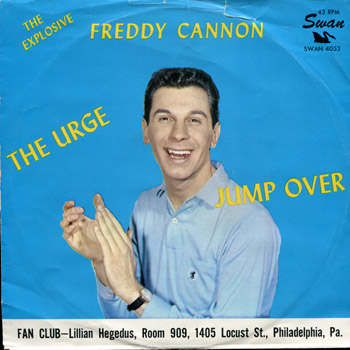
c
The third Swan release in a row for Freddy Cannon, to get it's own picture sleeve. A new blue background with a completely different picture has been used. The fan club announcement has more real estate, using a strip along the bottom of the sleeve.
The mid-tempo recording of "Jump Over" made it 5 for 5 on Billboard (#28), and spent 10 weeks on the charts. The flip was "The Urge" and rocked as hard as any side to date. It spent 3 weeks of it's own on Billboard.
This is a label variation. Again, this shows the large font used for the song titles, but all information is the same. Very often. later presses of records have bigger fonts.
Another picture sleeve was manufactured, again with the blue background. The back side promoted the first LP by Freddy Cannon, and also highlighted the "Treasure Chest Of Hits" LP by Swan. "Happy Shades Of Blue" was also the name of a concept album that was issued. Oddly, Cuernavaca Choo Choo got the top sleeve billing.
"Happy Shades Of Blue" was the next release and chart entry. Frank Slay and Bob Crewe continue to be responsible for the song writing credits on Freddy Cannon's hits. Peaking at number 83, it was flipped with Cuernavaca Choo Choo. The Phonetic spelling was on the label, and the tempo was a bit different than what Freddy had done up to this point.
Here is the Humdinger and "My Blue Heaven" sleeve. Another totally different shot of Freddy Cannon, with the fan club notice in the bottom left corner. The back of the sleeve is the same promotional message of the Swan Treasure Chest Of Hits along with Cannon's Explosive LP, just like the "Happy Shades Of Blue" picture sleeve shown earlier.
"Humdinger" spent a short 4 weeks on the chart, beginning in October of 1960. It has a catchy tune, and should have stayed longer than it did. I also like the partial group backup that is used. "My Blue Heaven" was on the back side. It is the same song that Fats Domino recorded.
The sixth record in a row with a picture sleeve, a live shot was chosen. Freddy Cannon has the appearance of tearing down the house, with his combo in the background.
Starting off 1961 was "Muskrat Ramble". It was likely the intended "B" side, as "Two Thousand-88" was written by Slay and Crewe. The T on the bottom of the label only shows the beginning of the title of the side. If the title starts with a "B", then they use the last letter of the title.
"Buzz Buzz A Diddle it" was the next record and chart hit. 8 weeks on Billboard, it seemed to get played much more than the numbers indicate. "Opportunity was the "B" side.
Label variation. Once again it is all in the font! This reached number fifty one on the Billboard charts in 1961
Using an orange background this time, they borrowed the picture from "Happy Shades Of Blue" and issued the sleeve shown above with Transistor Sister" and "Walk To The Moon". The flip is an advertisement for three Freddy Cannon LP's.
Rising to number 35, "Transistor Sister" gave Freddy his highest chart position since "Jump Over". This did appear to be the intended plug side, and the flip, "Walk To The Moon" was written by Slay and Crewe. It really doesn't matter which side is the hit if you write a song and it gets put on the record. You get royalties for your song based on the number of records sold.
A brief side trip to label mates Danny And The Juniors, who featured Freddy Cannon on "Twistin All Night Long". Released in early 1962. The "B" side "Some Kind Of Nut" did not include Freddy Cannon. The promotional issue is shown.
Freddy just skated into the top 100 in 1962 with "Teen Queen Of The Week". A nice side, it just didn't catch fire. "Wild Guy" was on the flip side.
Freddy Cannon came back strong with his next record. "Palisades Park" shot up to number 3 and stayed on the Billboard charts for 15 weeks. The record was a monster, and it revived his career. "June, July And August" was a decent flip that was the originally the intended "A" side.
Here is a label variation for "Palisades Park" You can see quotes on the titles with this issue. The flip, "June,July, And August, was a decent rocker on it's own.
As summer was coming to a close in 1962, Freddy Cannon released "What's Gonna Happen When Summer's Done" and flipped it with "Broadway" A new song writing team, Feldman,Goldstein, and Gottehrer, were used for both sides. The disc reached number forty four on the Billboard charts.
A really cool song was released in November of 1962 called "If You Were A Rock And Roll Record". It also hit the top 100, peaking at number 67. The "B" side was called "The Truth, Ruth". Different songwriters were on both sides, and they had not been used on Freddy Cannon records previously.
After sixteen straight top 100 records to the Billboard pop charts, Cannon's next release went under the radar. "Four Letter Man" was the plug side for January of 1963. "Come On And Love Me" was on the flip side. The promotional issue is shown.
Back to the charts, "Patty Baby" was a hard driving Freddy Cannon record that was great, and what we expected from him. Seven weeks on the charts and a top position of sixty five, it should have stayed longer. "Betty Jean" was a fantastic rocker with a great group sound.
There was always a new dance coming out, and Freddy Cannon's "Everybody Monkey" stopped at position number 52 on the charts. Another nice up tempo with a great organ. "Oh Gloria" is darn near Doo Wop, and is music to my ears! This was Freddy's last chart entry for Swan records.
Now on the black Swan label, Cannon sings "Do What The Hippies Do". This is a bit of a departure from his usual rock and roll records. "That's The Way Girls Are" was on the backside and sounded different as well.
"Sweet Georgia Brown" was his next Swan release. Cannon was trying to get back the sound of old by recording an older standard and adding his unique touch. "What A Party" was the "B" side. Released towards the end of 1963.
The last Freddy Cannon release for Swan records was "The Ups And Downs Of Love" Pictured however, is the UK issue on Stateside. This record did not sell well. Maybe it was because Freddy Cannon left for WB and it may have not received the needed promotion. Perhaps it was the title that the radio stations didn't like. It is a great sounding record. "It's Been Nice" is on the flip, released in 1964.
Freddie Cannon switched record labels from Swan to Warner Brothers. His first effort, again, made the charts. "Abigail Beecher" even spawned an album. "All American Girl" was the fine flip side and was included on that LP.
Next up was "OK Wheeler, The Used Car Dealer", shown on a promotional label. Typical rock and roll from Freddie Cannon on this "A" side. "Odie Cologne (Eau De Cologne) was on the flip. No chart action Nationally for this one.
"Summertime U.S.A." was release next in line, in June of 1964.Placed on the market just in time for summer, but did not chart. "Gotta Good Thing Goin" was the flip.
Taking a Chuck Berry standard for his next issue, "Too Much Monkey Business" was the plug side on this promotional Warner Brothers issue. A fun song was on the flip called "Little Autograph Seeker". Cannon was given partial writing credits on the flip side. I thought this was a great pairing and should have landed on the charts.
The only picture sleeve issued for Freddy Cannon on Warner Brothers. Both sides show "In The Night" as the "A" side, and are exactly the same. A nice colorful picture of Freddy Cannon.
"In The Night" was issued in 1965. The flip was "Little Miss A Go Go Go". Of note, the song writing team of Boyce-Hart were shown on the "A" side.
The next chart record since Abigail Beecher, this 1965 release of "Action" peaked at number 13 and stayed on the Billboard charts for 9 weeks. It was taken from the hit TV show Where The Action Is. "Beachwood City" was the "B" side.
"Let Me Show You Where It's At" is shown as the next Freddy Cannon release. "The Old Rag Man" appears with stars on the label, but did not seem to get the most spins. The all white promotional version is shown, and the record was released in 1965.
Here is the stock copy of Freddy Cannon's record from 1965. Freddy Cannon still had many more releases for Warner Brothers ahead of him.
The last Freddy Cannon release for 1965, "She's Something Else" was flipped with "Little Bitty Corrine." Another Warner Brothers promotional record.
The last charting record on Warner Brothers for Freddy Cannon was "The Dedication Song". It debuted on the Billboard charts in February 1966, and peaked at number forty one. "Come On Come On" was on the back side.
Step right up to "The Greatest Show On Earth", another black and white label promo. The "Hokie Pokie Girl" was the "B" side.
Next up for 1966, was "Natalie" and "The Laughing Song". Another promo copy, this was produced by Russ Regan.
"Run For The Sun" was another great fast paced summer song. A mention of Tallahassee Lassie is used, but the song is fun on it's own merit. The flip "Use Your Imagination" is based on the phrase, and is more mid 1960's sounding.
"In My Wildest Dreams" and "A Happy Clown" were the last pairing for 1966. Notice Leon Russell is listed as arranger.
Starting off 1967, "Maverick's Flat" backed with "Run To The Poet Man" was issued on a promotional Warner Brothers record. The flip showed Freddy Cannon's attempt to keep up with the times.
Freddy Cannon's last release for Warner Brothers was 20th Century Fox, which was the same as the Doors song. On the flip was Cincinnati Woman. Issued on a promo in 1967.
After Warner Brothers, Freddy Cannon recorded for a series of different labels. First up is a label called "We Make Rock And Roll Records", a subsidiary of Capitol. He cut the standard "Rock Around The Clock". The flip was "Sock It To The Judge". Click
HERE for a picture of the original sleeve. Released in 1968
The second and final issue for the "We Make Rock and Roll Records" label was "Sea Cruise". backed with "She's A Friday Night Fox." The promotional release is shown, complete with the Star on the plug side .Released in 1968
Next was the Sire label, distributed by London records. "Beautiful Downtown Burbank is the "A" side, in stereo. The title refers to a city in the Los Angeles area. "If You Give Me A Title" is the flip of this 1969 issue.
Here is the first issue for Freddy Cannon on the newly formed Royal American label. "Charged-Up Turned-On Rock N Roll Singer" backed with "I Ain 't Much But I'm Yours". The "A" side makes mention of several of his hits all collaged together. It's his usual up tempo performance, and is lots of fun. The flip is a ballad / up tempo with lots of orchestra.
Trying another release for Royal American, "Nite Time Lady" has the star and is flipped with the same song as the release above. It sounds like the same exact record and take.
Likely the third of three releases for the Royal American label, "Strawberry Wine" was designed for the spins, and "Blossom Dear" was the flip. Royal American was part of the Buddah records group. Released in 1970.
On to the previously mentioned parent, Buddah records for 1971. "Rockin Robin" was the choice for airplay, taking the Bobby Day standard and adding the Freddie Cannon touch. "Red Valley" was the "B" side.
A 1972 release on the Metromedia label, this has the same title on both sides. The difference is that one side is mono and the other is stereo. "If You've Got The Time" was the plug side, and for that matter, the plug side.
Jump ahead to 1974, and another promo with the same song on both sides, this time both in stereo. "Rock And Roll ABC's was sent to radio stations to drop the needle on.
From the Andee label out of Florida, "I Loves Ya" was the intended plug side. "Chomp Chomp, Sooey Sooey was on the back side of the record. This gave label credit to Cannon's Express. I also see Gary Paxton label credit.
A reissue of sorts for the Claridge label, they paired "Palisades Park" and "Way Down Yonder In New Orleans". The promotional copy is shown, and the label notes show this was part of the "Old Gold" series.
A second issue on Claridge was a "new" song set of "Sugar" and "Sugar Part Two." Shown is the promo version and this was released in 1976.
In 1981, Freddy Cannon recorded on the Los Angeles based Horn record label. "Suzanne Somers" was the "A" side and "Blankcheck's Market" was the "B" side. Note that it was co-produced by DJ Bob "Emperor" Hudson. The flip also included Connie Cannon.
The last chart entry to date for Freddy Cannon, was "Let's Put The Fun Back In Rock And Roll" on the MiaSound label from Florida. The record charted for 4 weeks in September of 1981. A great record that deserved to do better. The flip was "Your Mama Ain 't Always Right".
A stop at Amherst records of Buffalo New York in 1983 resulted in "Dance To The Bop". This was flipped with "She's A Mean Rebel Rouser."
Pictured above is the one sided picture sleeve issued with the Children's hospital fund raiser. The main sponsor was local radio station KDKA, one of the oldest AM radio stations in the country.
In 1987, Freddy Cannon released a record as a fund raiser for the children's hospital of Pittsburgh, PA. HQ records was the label, and it was done in association with KDKA TV and radio. "Kennywood Park" was the "A" side, with a tribute to the famous Pittsburgh area amusement park. "With A Little Love" was the KDKA children's hospital theme, on the flip side.
Back to Amherst with "Rockin In My Socks" from 1988. Shown is the promotional version. The flip is referred to as the "Instrumental Vocal" version.
Here is the stock copy of "Rockin In My Socks". This time the vocal is not mentioned, but the side with the instrumental track is identified.
Here is a 33 1/3 single from Amherst, which was manufactured on the twelve inch disc. It has the two songs from the 45 on side one and an extended mix on the flip.
Freddy Cannon is from the Boston area, and apparently is a big Red Sox fan. The colorful cover is shown above. complete with a baseball card of Freddy Cannon. The back of the sleeve is shown and looking like a montage of old print ads and a baseball scorecard showing the musicians on the records.
Teaming with Los Straightjackets, "The Sox Are Rockin" is the plug side, and a good song. "Red Sox Nation" is on the back. This was issued on the Spinout label.
From 2013, here are both sides of the 45 RPM cover Freddy Cannon and the Gears. Freddy's image can be seen on the left cover above, in the top back of the hot rod.
Freddy Boom Boom Cannon and the Gears! "Keep Movin" appears to be the plug side and "Move It On over" is the flip. I'm sure airplay on either side would be just fine with the artists. Released on Wondersap records.
Here is the stereo issue of the Explosive Freddy Cannon. Swan did not issue too many LP's in the late 50's and early 60's, and this was the first in stereo. In fact it would be several years later before they would attempt another stereo LP. You can see the Stereo indication towards the lower right of the front cover, and prominently on the top middle of the label below. Also of note, the version of Tallahassee lassie is different than the single, and had a big band sound to it.
These are the stereo Swan labels for Freddy Cannon's first LP for Swan. As you can see from the song titles, he made sure each song title mentioned a city or state.
Freddy Cannon's LP was released in 1960. The back cover seems to be identical to the Stereo back cover.
Here are the mono labels for "The Explosive Freddy Cannon." Freddy Cannon has always been a favorite artist of mine.
"Solid Gold Hits" was Freddy Cannon's next LP, from 1961. This had a really colorful cover. The big hits from Swan were featured in a great LP.
Here are the mono Swan labels. If you were looking for a greatest hits package for the Swan recordings, this is it!
In 1962, a concept LP was released called Happy Shades Of Blue. All the songs had "Blue" in the titles.
These are the Swan labels for the Blue LP. He has a combination of his hits that had blue in the titles, along with some classics. These included current and older songs.
To follow through on the great success of Palisades Park, Swan released an album of the same name, also in 1962. The single did so well for Freddy Cannon, and really revived/boosted his career.
Both labels are shown above. Freddy Cannon sings the Bobby Darin song, "Splish Splash", a few of his Swan hits, and more classics as well.
The last Swan album for Freddy Cannon was called "Freddy Cannon Steps Out" and includes more great 45's from the Swan catalog. It has a cover that gives the illusion of an older time in history.
In spite of the older looking cover, the songs chosen for the LP were current, with a total of twelve cuts.
After switching to Warner Brothers with his singles, it was only natural for them to issue an album. This self titled LP included his first Warner Brothers hit called "Abigail Beecher". This LP was from 1963, and the Stereo issue is shown.
On the gold Warner Brothers label, here are the labels for the "Freddie Cannon" LP. I noticed that the spelling of Freddie's/Freddy's name has changed, and it actually tends to vary on some of his releases.
Freddy's next big hit on Warner Brothers, "Action", spurned an LP of nearly the same title - "Action! Is What's Happening, Baby." Shown above is the stereo covers.
The now familiar gold Warner Brothers LP labels for the Freddie Cannon LP"Action" He has a mixture of WB releases and some other popular songs of the day.
Naturally, "Action" was also pressed in regular mono, as shown above.
Warner Brothers Vitaphonic High Fidelity mono grey labels are shown above for the Action LP.
Freddy Cannon's last album for Warner Brothers was a Greatest Hits LP. It was released in 1964, and it had the best of the Warner Brothers records.
This time the gold label is not stereo, but is recorded in glorious monaural sound.
Updates: Freddy Cannon recorded a lot of records. Most, but not all, are shown above. He also had many International records that were released in most countries. He was, and is a dynamic performer, and sings straight ahead rock and roll.
Site Map For colorradio.com - All Page Links
